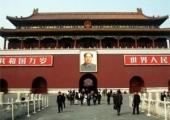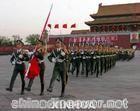
Overview
The Tiananmen Square in the center of Beijing, is said to be the biggest square in the world. It is 880 meters from north to south, and 500 meters from east to west, with total area of 440,000 square meters and can hold one million people.
Tian'anmen Spuare is the spiritual heart of the world's most populous country. It earned this distinction by serving as the stage for momentous historical events, like the demonstrations on May 4th 1949 that inspired young Chinese to fight imperialists and warlords, and build a strong independent country. Among those swept up in the ferment of the "May Fourth Movement" was Mao Zedong who would help found the Communist Party of China two years later.
Know more
 On October 1st, 1949, Mao climbed atop the "Gate of Heavenly Peace", which gives the spuare its name, to proclaim the fundation of the People's Republic of China.
On October 1st, 1949, Mao climbed atop the "Gate of Heavenly Peace", which gives the spuare its name, to proclaim the fundation of the People's Republic of China.
In 1949, Tian'anmen Square was a narrow walled plaza, but it was expanded in the 1950's to its present size of 400,000m2 . The site of major parades the spuare has also played host to impromptu celebrations as when Beijing was awarded the 2008 Olympic Games in July 2001.
 Most days Tian'anmen Square is filled with sightseers and kite-flyers. During national holidays, it's usually festooned with banners and floral decorations. Many Chinese visti at dqwn or dusk to see elite People's Liberation Army troops conduct flag raising ro lowering ceremonies.
Most days Tian'anmen Square is filled with sightseers and kite-flyers. During national holidays, it's usually festooned with banners and floral decorations. Many Chinese visti at dqwn or dusk to see elite People's Liberation Army troops conduct flag raising ro lowering ceremonies.
Must see 
Huabiao on the Tiananmen Square:
A well-known architectural ornament in China is the huabiao, often seen on the grounds of palaces, imperial gardens and mausoleums. It is also seen at some crossroads to mark the throroughfares.
There is a pair of such ornamental pillars carved out of marble standing in front and behind Tian'anmen, the Gate of Heavenly Peace, at the centre of Beijing. Each pillar, entwined by a divine dragon engraved in relief, carried a plate on top called CHENGLUPAN for collecting dew on which squats an animal called kong .
On the square's north end is the Gate of Heavenly Peace, which leads towards the Forbidden City. Above the gate hangs the famous portrait of Chairman Mao. On both sides of the gate are inscriptions in Chinese: the one on the left says, "Lone Live the People's Republic of China"; the one on the right declares, "Long Live the Unity of the people of the World." For a panoramic view of the spuare, ascend to the panoramic view of the spuare, ascend to the top of the Gate, where Mao proclaimed the establishment of the PRC.
In the center of the square is the 40m-high Monument to the ;People's Heroes, an obelisk with friezes de;picting revolutionary heroes and calligraphy by Mao Zedong and former Premier Zhou Enlai. South of the monument is the Chairman Mao's Mausoleum, where you can peer at the embalmed figure of the Great Helmsman in his glass casket. Standing guard over the square's southern end, behind the mausoleum, is 600-year-old Qianmen one of the few remaining Ming-era city gates. The building on the Spuare's east side houses the Chinese History and Revolution Museum.
The imposing edifice on the west side of Tian'anmen Square is the Great Hall of the People. Built in a speedy 10 months in 1958 to 1959, it's home to China's parliament , the National People's Congress.
